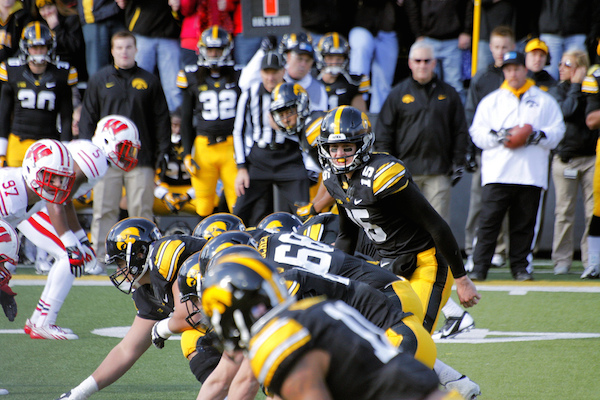Dear Sports Fan,
What does down by contact mean in football? I hear people talking about it when a player fumbles the ball. Does it have something to do with fumbling?
Thanks,
Bruce
Dear Bruce,
There are two ways for an NFL football player who has established control of the ball to be ruled down by contact. Either contact with an opposing player forces a part of his body other than his hands or feet to touch the ground or a player from the opposing team touches him while a part of his body other than his hands or feet are touching the ground (even if it wasn’t contact with that player that forced him to the ground.) In other words, a ball carrier is down by contact if he’s touched while on the ground or if contact with an opposing player forces him to the ground. In college football, the rules are different, but in the NFL, when these conditions have been met, that play is over and anything that happens afterwards, good or bad for either team, should not count. A player cannot fumble the ball once he is down by contact nor can he score a touchdown or earn a first down. Generally, as you pointed out in your question, if you hear people talk about whether a player is down by contact, it’s because one of those three things may have happened. In this post, we’ll run through a scenario for a fumble and for a touchdown (a first down scenario is identical to a touchdown one) as a means of explaining the down by contact rule.
Is a player down by contact or has he fumbled?
Imagine a wide receiver running down the field. The quarterback delivers a perfect back shoulder pass which the receiver catches easily. He secures the ball, cuts to the middle of the field, and fakes out one defender before being tackled by another. As he’s falling forward, the ball squirts loose and rolls around on the ground for a while before the defender picks it up. The defender runs the ball a few yards up the field before stepping out-of-bounds. He and his teammates are celebrating because they feel they’ve created a turnover and their offense should get the ball. The wide receiver is indignantly yelling at the ref that his knee was down before he lost control of the football. Not to worry, in the NFL all potential turnovers are subject to automatic video replay.
The question for this review is whether the wide receiver should be ruled down by contact or whether he fumbled the ball. The official looking at the video will go through a series of questions about the player in question. First, did he establish control of the ball? Yes, he caught it and then ran a bit with the ball, clearly establishing control. Second, was he forced to the ground by a player on the defensive team? Yes, a defender tackled him. Finally, the key question – was he in possession of the ball when a part of his body other than his hands or feet, in this case, his knee, first touched the ground thanks to the action of a defender? If the answer to that question is yes, then the player did not fumble the ball, he simply dropped it after the play was over — once he was down by contact.
Has a player scored a touchdown or was he down by contact?
In this scenario, a running back takes a handoff from the five yard line. He swings out wide, near the edge of the field, and thanks to some great blocking or trickery by his team, he has a clear path to the end zone. Alas, he trips on an errant tuft of grass. Not to worry, this isn’t college football, where the play is over as soon as any part of a ball carrier’s body other than his hands or feet touch the ground. This is the NFL where the down by contact rule tells us that a player with the ball must be on the ground AND touched by an opponent before the play is over. So, the running back starts wriggling his way toward the goal line. All he has to do is get the tip of the ball to the line to score. As he’s wriggling and squiggling and reaching out to score, a defender runs over and dives at him, touching his back with outstretched arms. The refs call it a touchdown but, since all scoring plays are automatically reviewed, and the ref runs to the video monitor to take a second look.
In this scenario, there’s no question about the ball carrier having possession of the ball. The running back takes it from the quarterback and holds onto it for the entire play. There’s also no question about when the player’s knees, butt, elbows, etc. touch the ground. He falls on his own and then maintains contact with the ground for the rest of the play, crawling along. The only question is when the ball carrier was first touched by an opposing player, which would make him down by contact and end the play. Did the touch happen before or after the ball reached the goal line? After looking at the video and freezing it the moment the ball carrier was touched by a defender, the ref concludes that the ball had not reached the goal line yet. No touchdown is awarded but the offense gets to start the next play with the ball six inches from the goal line, the distance it was when the ball carrier was touched and therefore down by contact.
—
Hopefully these two scenarios have helped to demystify the down by contact rule in the NFL. Show off to your friends the next time the issue comes up in a game you’re watching!
Thanks for reading,
Ezra Fischer










